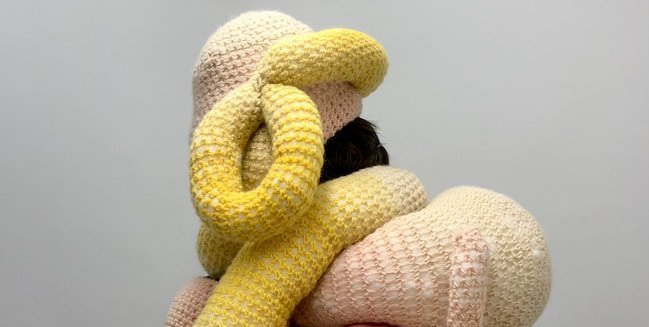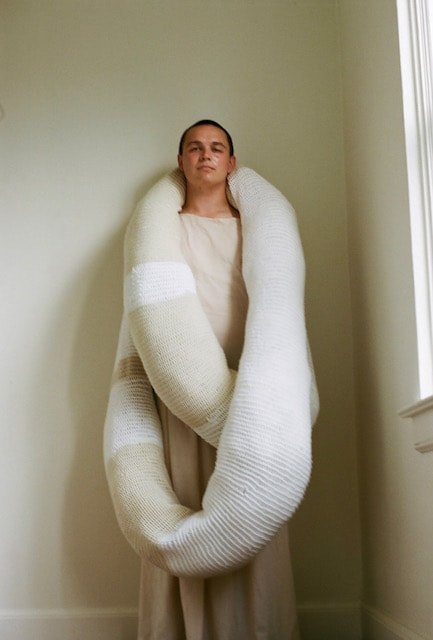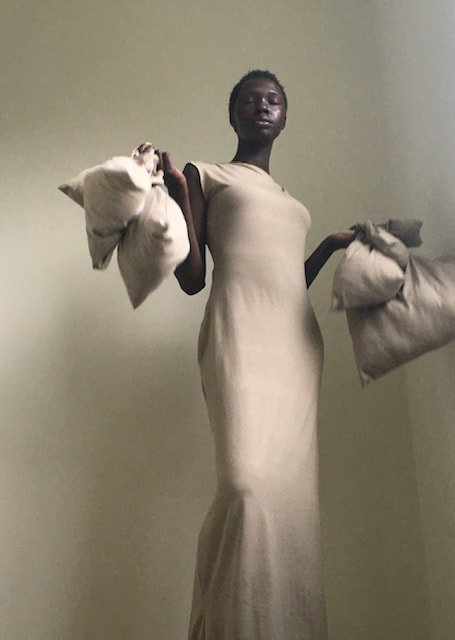"Fashion is Ridiculous!" —
a Feature With Myah Hasbany
By Amber Weir
November 12, 2021

Image and Garment by Myah Hasbany
There is nothing instinctive about hungry machines in the fashion industry endlessly churning out replicated items of clothing. To view the mass production of fashion as natural is to become complicit in a persuasive myth that limits designers’ creative potential: their work becomes disposable, repetitive, and predictable.
Meet Myah Hasbany, a 19-year old from Dallas studying fashion design with marketing at Central Saint Martins in London, who is transparent about the design industry, declaring: “Fashion is so ridiculous!”
Hasbany’s ethos as a designer is that “we don’t need any more clothes.” Rather than contributing to the mass production of clothing, Hasbany creates unique garments for artistic expression, which embody her own experience and emotions since that can’t be replicated. Hasbany started out in fine arts and combines her knowledge of art techniques with fashion design techniques to create sculptured, structured couture. Hasbany resists using traditional fashion silhouettes, creating designs that are humorous, and not functional for daily life.
“No one is ready to admit fashion isn’t sustainable. It’s worth making a mockery!” she says.
Hasbany sketches, collages, paints, explores fabrics, reads philosophy, and falls down the abyss of endless videos on Youtube when coming up with her designs. This process makes her designs multi-faceted and highly textured, as they come to embody many different influences.
Hasbany wanted to study marketing with her fashion degree because she aims to make her design exhibitions in the future a full experience. She is heavily inspired by the Rick Owens Runways, because he is able to “create a world with scents, music, and space.”
![]()
![]()
One of the reasons why Hasbany was drawn to London’s Central Saint Martins, was because as an institution “they looked at the whole picture, rather than just how to make a jacket.”This is seen by legendary designers who attended Central Saint Martin’s university such as Alexander McQueen, John Gallino, and Stella McCartney.
Though applying to Central Saint Martins design program from Dallas was an extremely stressful experience for Hasbany, she used her anxiety as inspiration. Hasbany felt caged in and reflected this feeling by creating a sculptured top made from plaster, which physically trapped her arms. She then canvases hand-painted images of herself crying across the skirt to convey how difficult this experience was.
"I wanted to explore how I could represent my internal struggles in a physical way as a way to cope.” she says.
When Hasbany moved from Dallas to London and began university, she began to see her home country through a new lens. Hasbany used this narrative as inspiration for a design project called American Exceptionalism versus American Realism. The central idea which underpinned this collection was her criticism of American exceptionalism, which she had grown up with.
“I wanted to capture how it feels to live under this blanket of pride while not believing in any of it,” she says.
Hasbany also embeds humor into her pieces. One of the designs in American Exceptionalism versus American Realism, had a hole in the middle of it, just because.
“Fashion is so ridiculous. If I am going to make stuff, it is going to be ridiculous,” she says.
Meet Myah Hasbany, a 19-year old from Dallas studying fashion design with marketing at Central Saint Martins in London, who is transparent about the design industry, declaring: “Fashion is so ridiculous!”
Hasbany’s ethos as a designer is that “we don’t need any more clothes.” Rather than contributing to the mass production of clothing, Hasbany creates unique garments for artistic expression, which embody her own experience and emotions since that can’t be replicated. Hasbany started out in fine arts and combines her knowledge of art techniques with fashion design techniques to create sculptured, structured couture. Hasbany resists using traditional fashion silhouettes, creating designs that are humorous, and not functional for daily life.
“No one is ready to admit fashion isn’t sustainable. It’s worth making a mockery!” she says.
Hasbany sketches, collages, paints, explores fabrics, reads philosophy, and falls down the abyss of endless videos on Youtube when coming up with her designs. This process makes her designs multi-faceted and highly textured, as they come to embody many different influences.
Hasbany wanted to study marketing with her fashion degree because she aims to make her design exhibitions in the future a full experience. She is heavily inspired by the Rick Owens Runways, because he is able to “create a world with scents, music, and space.”


Image and Garment by Myah Hasbany
One of the reasons why Hasbany was drawn to London’s Central Saint Martins, was because as an institution “they looked at the whole picture, rather than just how to make a jacket.”This is seen by legendary designers who attended Central Saint Martin’s university such as Alexander McQueen, John Gallino, and Stella McCartney.
Though applying to Central Saint Martins design program from Dallas was an extremely stressful experience for Hasbany, she used her anxiety as inspiration. Hasbany felt caged in and reflected this feeling by creating a sculptured top made from plaster, which physically trapped her arms. She then canvases hand-painted images of herself crying across the skirt to convey how difficult this experience was.
"I wanted to explore how I could represent my internal struggles in a physical way as a way to cope.” she says.
When Hasbany moved from Dallas to London and began university, she began to see her home country through a new lens. Hasbany used this narrative as inspiration for a design project called American Exceptionalism versus American Realism. The central idea which underpinned this collection was her criticism of American exceptionalism, which she had grown up with.
“I wanted to capture how it feels to live under this blanket of pride while not believing in any of it,” she says.
Hasbany also embeds humor into her pieces. One of the designs in American Exceptionalism versus American Realism, had a hole in the middle of it, just because.
“Fashion is so ridiculous. If I am going to make stuff, it is going to be ridiculous,” she says.
Hasbany’s design process is very abstract. “I will have a shape or mood when I start,” she says. “It doesn’t have to be like my sketchbook.” Understanding that the design process is dynamic, Hasbany is happy to experiment and shift her designs as the process unfolds. Hasbany crocheted parts in her American Exceptionalism versus American Realism and loved the freedom she had to build shapes.
Another one of Hasbany’s Central Saint Martin’s projects was centered around creating a lanyard to hold an ID card. Hasbany used her mother as her muse. The small ID card was to present the different roles her mother played in society. The pieces on the couture could come apart and be reassembled in different combinations. “The hope was that if others could see the pressures that people had to endure in a physical way through the tags, maybe we could show more empathy to each other,” Hasbany says about the project.
Another one of Hasbany’s Central Saint Martin’s projects was centered around creating a lanyard to hold an ID card. Hasbany used her mother as her muse. The small ID card was to present the different roles her mother played in society. The pieces on the couture could come apart and be reassembled in different combinations. “The hope was that if others could see the pressures that people had to endure in a physical way through the tags, maybe we could show more empathy to each other,” Hasbany says about the project.

Image and Garment by Myah Hasbany
Hasbany also experiments with creating custom-pieces. Just last year, Hasbany designed a garment for the iconic neo-soul artist Erykah Badu to wear at one of her live-stream concerts. She loved the experience, and Badu immediately understood the artistic nature of Hasbany’s designs. The bond between creative minds is a powerful connection.
“Designing for someone else is different than creating for yourself because your designs have to fit their world,” she says. “For a performer, the designs need to be movable, wearable, and technically appropriate.”
Ultimately, Hasbany makes us wonder what distinguishes art from fashion. The truth is, fashion is art, and art is fashion. Hasbany’s designs reflect her experiences, and also reflect narratives to make the audience think. Art has the power to make people feel and view the world differently. Through subverting the usual design conventions, Hasbany mocks the fashion industry in a form of artistic expression to show fashion can be ridiculous, yet, still emotive and creative. Hasbany is only in her second year of university and we are excited to see her designs in the future.
In a world where fast trends rule the fashion industry for a transient moment, Hasbany’s designs ground us, reminding us that longevity lies in the unique artwork that cannot be replicated. ■
“Designing for someone else is different than creating for yourself because your designs have to fit their world,” she says. “For a performer, the designs need to be movable, wearable, and technically appropriate.”
Ultimately, Hasbany makes us wonder what distinguishes art from fashion. The truth is, fashion is art, and art is fashion. Hasbany’s designs reflect her experiences, and also reflect narratives to make the audience think. Art has the power to make people feel and view the world differently. Through subverting the usual design conventions, Hasbany mocks the fashion industry in a form of artistic expression to show fashion can be ridiculous, yet, still emotive and creative. Hasbany is only in her second year of university and we are excited to see her designs in the future.
In a world where fast trends rule the fashion industry for a transient moment, Hasbany’s designs ground us, reminding us that longevity lies in the unique artwork that cannot be replicated. ■
Other Stories in Fashion
© 2024 SPARK. All Rights Reserved.
